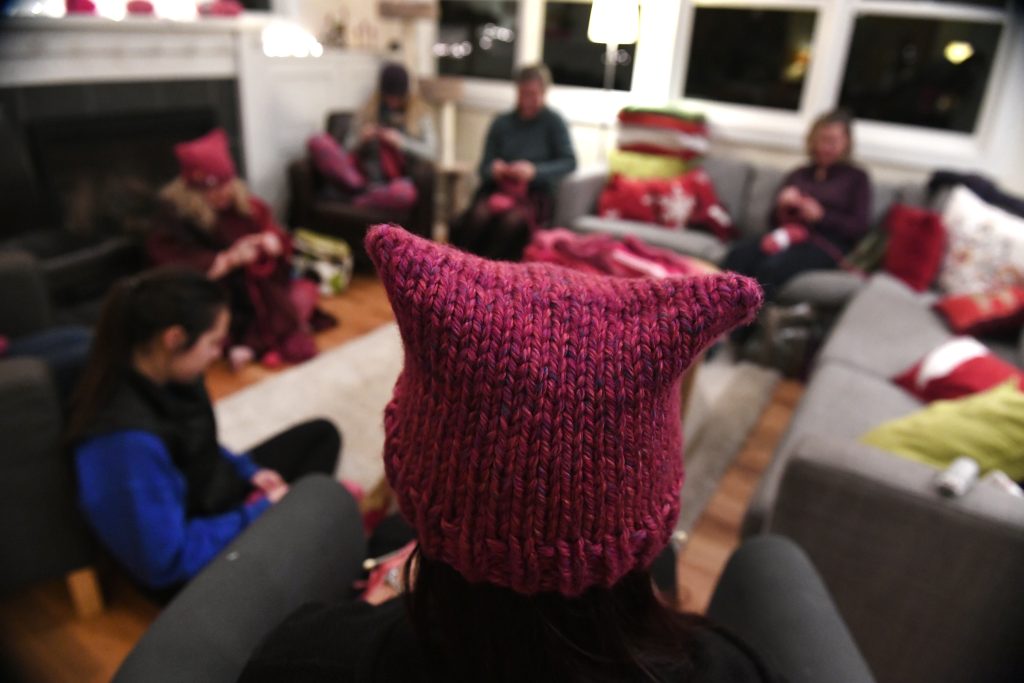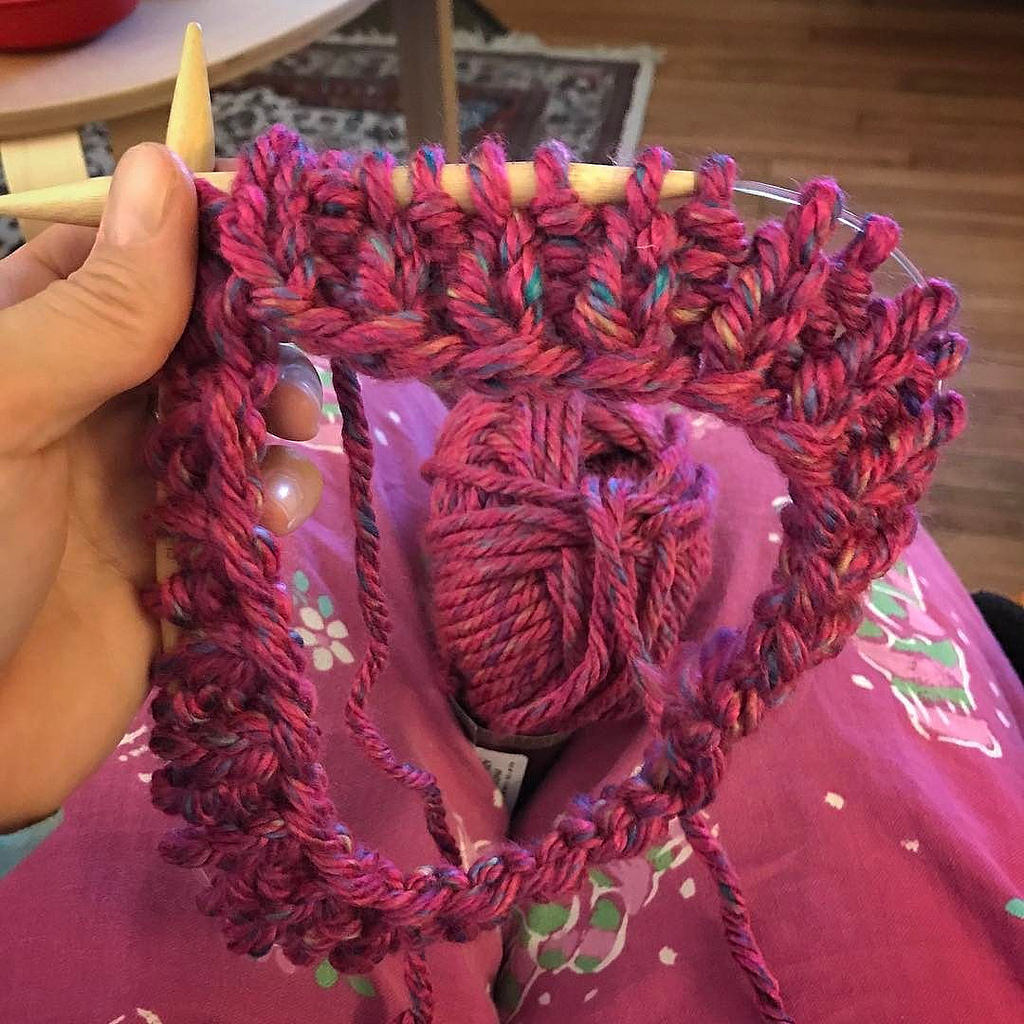How Will the Power of the Pussyhat Endure?

I love my pussyhat, a knitted, pink, square affair whose top corners poke out like cat ears. I wore it to my local women’s march, one of perhaps 600-plus worldwide offshoots of the January 21 Women’s March on Washington in D.C. I marched because I wanted to remind my new president that our government exists to protect the nation’s most vulnerable citizens—not to further enrich and empower the elite, whose status and wealth are often built on the backs of the marginalized and the disadvantaged. Also, I had promised a friend that I would go.
The Pussyhat Project was founded by California knitters Krista Suh and Jayna Zweiman in the wake of the 2016 U.S. presidential election. They posted the original knitting pattern for the iconic hat, designed by Kat Coyle, online. Crochet and sewing patterns followed. Conceived in part because it would be cold in the capitol but also in the hope of creating a unique, collective visual statement—and to enable those unable to travel to or march in D.C. to participate—their “craftivist” project invited and inspired volunteers to make hats and send them to central collection sites. Suh and Zweiman aimed for 1.17 million hats, enough to fill the National Mall in D.C. when worn by marchers. A minimum of 100,000 were distributed—and many more were worn at the myriad sister marches that took place around the world.
After knitting a litter of pussyhats with friends and sending them off, I realized I wanted a hat too. With all the pink yarn in my home cleaned out, and local shops reporting shortages (as did many across the nation), I remembered an unfinished pair of socks as near to the recommended hue as I was going to get: socks that my son had been knitting. With his permission—“Go for it, mom,” he said—I unraveled the weave to recycle the wool. Just after midnight, in time for the morning’s march, my hat was complete, its color more peachy-rose than hot pink but that didn’t matter: Every pussyhat, like the individuals who wear them, is unique.The project aimed to reclaim a culturally feminine (ostensibly weak) color. Pink, the project’s leaders say on their website, represents caring, compassion, and love—“all qualities that have been derided as weak but are actually STRONG.” They also note that knitting and knitting circles are often considered frivolous by modern culture, while knitting actually is skilled work and knitting groups have long served as important social organizations. The hat’s very name repossesses an otherwise disparaging label for female genitalia while referencing Donald Trump’s infamous comments describing sexual assault on the Access Hollywood tape. In such ways, pussyhats turn derogation into self-celebration, just as the Women’s March transformed what many viewed as a distressing moment in history into an opportunity for hope and action.
In this aspect, pussyhats differ from the red caps of the “Make America Great Again” (MAGA) campaign. Those caps are factory-made and therefore uniform. Not gifted but purchased, Trump’s red caps stand as a symbol of our industrial economy in which money distances—or, as Karl Marx might say, alienates—producers from their labor and from what they produce, and separates production from consumption. When money and goods change hands in a capitalist society, human relationships are severed. Consumers pay for red MAGA caps and wear them without a second thought for the sellers let alone the makers, who are often overseas laborers. Easily acquired, such mass-produced objects are typically as easily discarded; they have no intrinsic connection to other people.
Pussyhats, by contrast, are handmade—and gifted, not purchased. Handcrafting an object these days is a labor of love, and the love put into knitting a gift gets passed along with it. Marchers who were given pussyhats and those who made them were tied to one another through the gifting process. Wearers sent knitters cards, emails, and photos as expressions of thanks, and many are still wearing their hats with pride or sentimentally.
Some of the knitting circles that formed expressly to foster pussyhat-making will continue long into the future—not just for creating more hats (requests are still coming in) but also for community organizing as well as sharing information. And conversations are continuing between makers and receivers, even at long distances.
In generating personal bonds that endure, the pussyhat phenomenon has much in common with the gifting economies analyzed by anthropologists such as Marcel Mauss early in the 20th century. The Trobriand Islanders of what is now Papua New Guinea, as described by Bronisław Malinowski in his 1922 book Argonauts of the Western Pacific, provide an extreme example. They traveled great distances to exchange what appeared to Malinowski to be “worthless trinkets” with no practical utility. They did so to build community, creating strong bonds between those who gifted and those who received the gifts. A market economy, where money is used to buy and sell objects, doesn’t typically foster enduring links between people involved in an exchange.
In addition to these differences, red caps emphasize conformity. Pussyhats, each with its own history and appearance, do not. Having been handcrafted, pussyhats are uniform neither in color nor detail: “Every pussyhat’s different,” more than one marcher undoubtedly said.
And yet, the pink and red hats do share some qualities. Both create a sense of unity: When viewed en masse, pussyhats transformed individual marchers into one pink sea. And the signature Trump hats created a wash of red at Trump rallies. Both kinds of hat can also foster the emergence of a single overt identification that masks more complex and subtle differences of opinion.
In a country so divided as ours, anything that intensifies polarization spells danger. Once people feel compelled to choose between the pink hat and the red hat, divisiveness becomes self-reinforcing. The moment someone has committed to a “side,” defending that choice can become a point of pride: One’s identity can become tied up in the color of one’s hat. It’s hard to explore—let alone embrace—alternative viewpoints, to keep one foot in both camps, or to bridge differences when wearing one group’s particular color or “uniform.” Militaries and team sports organizations have long leveraged this propensity. Even in less explicitly organized communities, the desire for belonging and group cohesion serves as a powerful social force, fostering strong us-them divisions.
Pussyhats put us on the horns of a dilemma here. Like many marchers, I feel very close to my hat: Handcrafted, each one is as full of meaning as of its maker’s caring spirit. It would be hard to put aside something that symbolizes a heartfelt desire for a more loving nation—particularly when received as a gift. Yet by keeping our pink and red hats on, we may be excluding the possibility of an America that is both Republican-led and supportive of women’s rights and affiliated agendas. We may be deepening the divide by signaling team allegiance when instead we could be joining together (as in a league) to make caring for each other a common, nonpartisan cause.
I marched with people of all ethnicities, ages, genders, and religions. Participants seen by outsiders only as anti-Trump in fact voiced their support for a broad array of human rights causes. Wearing pussyhats did not erase these distinctions; rather, it helped to bridge them. Intersectional ties were created: the kind necessary for solving big problems.
Forging bipartisan alliances can—and should—also be part of this process. To foster those, we need to quiet the coarser-grained identity politics our hats have been caught up in. This does not mean tucking our precious pussyhats away in drawers; rather, it means building on the project’s success in bringing people together.
One way to do this might be to cultivate bipartisan knitting circles. People crafting together talk together; such communion can foster understanding, empathy, and compassion. So can knitting for others, particularly when warm items such as caps, scarves, and mittens are truly needed.
We can also continue to personalize the original pussyhat pattern. Maybe soon, we can individualize our hats not just in terms of the stitchery but in our color choices too so that each is even more unique. Unity does not demand uniformity; the iconic shape, still signaling the importance of human rights, will be beautiful in any shade or hue. And, if our democratic efforts make their mark, perhaps in a future time we can upcycle our pussyhats: We can unravel and repurpose the yarn for totally new projects, just as I did with those socks. We can make a new kind of hat—one that all Americans can proudly wear.
An earlier version of this essay was published at The Huffington Post.



























